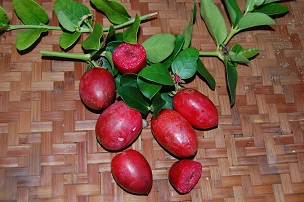From Fairchild
Tropical Botanic Garden
by Noris Ledesma, Curator of Tropical fruit
The Natal Plum
As published in the Miami Herald

How
would you like to have a beautiful, low-maintenance hedge that produces
delicious fruit year-round growing in your landscape? The Natal plum is
just such a plant and its dense foliage and thorns make it an effective
barrier or security hedge. Add on the deliciously fragrant blossoms and
deep green hue of the leaves and it's hard to think of a better shrub
for the tropical garden.
Natal plum is native to the Natal
Province of South Africa and was a popular landscape tree in South
Florida in the 1950s. It is a member of a large and diverse family of
plants that include the frangipani. It is a good alternative for
seaside properties in South Florida because of its tolerance to salt
spray and resistance to damage by wind. It is also well adapted to
drought and will require little watering.
The plant will grow to
about 10 feet with dark glossy green leaves that are thick and
leathery, and arranged in opposing pairs. Forked spines, arm the
branches and the ends of the twigs. Broken twigs exude a white milky
sap that is harmless, yet can be a nuisance when working with the
plant. The Natal plum produces an abundance of white star-shaped
flowers with five thick and waxy petals. The flowers are sweetly
fragrant, like orange blossoms. The edible fruit is a pretty
plum-shaped red berry about 2 inches long which tastes like sweet
cranberries with overtones of strawberry or apple. Natal plum blooms
almost all year long and most of the time both flowers and fruit are
present.
Natal plum fruits are rich in Vitamin C, calcium,
magnesium and phosphorus. The fruit is especially delicious directly
out-of-hand or can be made in juice, jelly, pies or syrups. For
harvesting, select large, firm and ripe fruit. If eaten before fully
ripe, white, bitter latex is released from the skin. But, you will have
to act fast, for the fruit also are eagerly consumed by birds.
Normally
Natal plum is propagated by cuttings or can be air layered. It grows
quite well on all of our Florida soils, preferring sandy soils. Plants
grow well right along the beach path. It makes a perfect option for a
container plant on ocean front condominium balconies. In the high
alkaline soils of extreme south Florida it must be fertilized more
frequently with trace elements to keep them growing well. A commercial
fertilizer 6-6-6, 3 times a year would be adequate for good growth and
optimum fruit production.
Young Natal plums are sensitive to
cold and they should be protected from temperatures bellow 29F. Once
older plants are establish they become cold hardy and take temperatures
of 25F without being killed. If the plant is damaged by cold it may
freeze to the ground, but it usually comes back in spring.
Natal
plum prefers sunny locations and well-drained soils. The plants have a
strong root system and a spreading growth habit and general ruggedness
that make them well suited for covering exposed ground and preventing
erosion. They are not tolerant of flooded conditions and will die if
they are submerged for more than a few days. Natal plum prefers to be
kept relatively dry and can be severely hampered by overwatering.
It
responds well to close pruning and is easily kept at any size. Many of
the improved cultivars found in local nurseries have a tendency to
revert to a more wild state and it may become necessary to frequently
prune off these unwanted reversions (branches). Natal plum plants are
found in local nurseries and there are several selections commonly
sold, including dwarf types.
Back to
Carissa Page
|
|